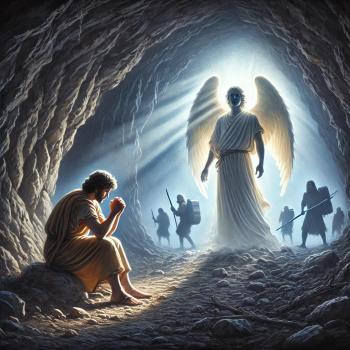Revelation 14:1-5 Jesus and His 144,000
Earlier, in Revelation 7, the Bible showed us who the 144,000 were and their purpose. When we look at the 144,000 in these verses in Revelation 14, we see that the Bible is describing their character and behavior.
As we have said in Revelation 7, there are two main views. The first is a literal view – that these are 144,000 Jewish evangelists. As Warren Wiersbe notes: This special group of Jewish men was sealed by God before the seventh seal was opened (Rev. 7), and now they are seen on Mount Zion with the Lord Jesus Christ. Contrast this picture to the one described in Revelation 13: the followers of “the beast” whose mark is on their foreheads (Rev. 13:16). God always has His faithful people, no matter how wicked the world may become.1
The other main view is that the number is probably symbolic of the vast and complete number of God’s people.2 Other scholars like Michael Wilcock note that they are the followers, or disciples, of Christ, and the first fruits of his harvest. Those who follow the Lamb form the civitas Dei, the city (or state) of God, as opposed to those who worship the beast from the sea, and form Satan’s perversion of the state.3
SEVEN CHARACTERISTICS OF THE 144,000
1. They identify with Jesus (Revelation 14:1)
“Then I looked, and there on Mount Zion stood the Lamb, and with Him were 144,000 who had His name and His Father’s name written on their foreheads.” (Revelation 14:1, HCSB)
The scene is in obvious contrast to the beast of chapter 13, whose followers are stamped with his mark (666) on the right hand or forehead (vv. 16–17).4 These believers identify with Jesus, not the Antichrist. They have the name of God and Jesus on their foreheads.
2. They have been protected from the persecution of the Antichrist (Revelation 14:1)
“Then I looked, and there on Mount Zion stood the Lamb, and with Him were 144,000 who had His name and His Father’s name written on their foreheads.” (Revelation 14:1, HCSB)
In chapter 7, we read of twelve thousand from each of the twelve tribes of Israel who will go throughout the world preaching the gospel. Although they will be targets of Antichrist’s persecution, here in the middle of the Tribulation, we still see 144,000 witnesses. In other words, they all make it through.5 Despite the intense persecution, they are now standing with Jesus.
As we will later see in this chapter, God will use other ways to get His message out. He will increase the opportunity for people to hear about Jesus.
3. They sense glory of God (Revelation 14:2)
“I heard a sound from heaven like the sound of cascading waters and like the rumbling of loud thunder. The sound I heard was also like harpists playing on their harps.” (Revelation 14:2, HCSB)
In the book of Revelation, God’s glory and voice are compared to loud thunder. It is literally music to the ears of the 144,000. They listen forward to God’s glory and sense it.
4. They sing a new song of victory (Revelation 14:3)
“They sang a new song before the throne and before the four living creatures and the elders, but no one could learn the song except the 144,000 who had been redeemed from the earth.” (Revelation 14:3, HCSB)
It is the “new song” of 5:9, but now it is sung by the very ones who have been purchased by the blood of the Lamb and made a kingdom of priests before the heavenly throne. As in so many of the “new songs” spoken of in the Psalms (96:1; 98:1; 144:9; etc.), the theme is deliverance. Only those who have paid the full price of endurance in the faith are equipped by experience to give voice to the subsequent anthem of victory.6
Dietrich Bonhoeffer sheds light on the identity of the song:
What do we know of that new song and the harps of God? Our new song is an earthly song, a song of pilgrims and sojourners on whom the Word of God has dawned to light their way. Our earthly song is bound to God’s Word of revelation in Jesus Christ. It is the simple song of the children of this earth who have been called to be God’s children, not ecstatic, not enraptured, but soberly, gratefully, devoutly focused on God’s revealed Word.7
5. They are pure. (Revelation 14:4)
“These are the ones not defiled with women, for they have kept their virginity…” (Revelation 14:4, HCSB)
On the surface it appears that John is condemning both women and marriage, but he is speaking figuratively about spiritual truths. Given the symbolic understanding of the 144,000, the contrast in Revelation between godly women and evil women (e.g., the great prostitute Babylon/Rome vs. the bride of Christ), and the enormous problems associated with a literal reading, the term “virgins” should be understood as a metaphor for all genuine believers who have refused to compromise with the world.89
The point of the purity is not to recognize that these men have not had sex. The virginity points to their devotion to Jesus. This is why it is connected to the idea they follow Jesus. Their devotion to Him is pure. In contrast to the spiritually and sexually impure world of the Antichrist, the 144,000 show us that following Jesus means taking spirituality seriously.
6. They show us a true picture of what it means to be a disciple of Jesus (Revelation 14:4)
“…These are the ones who follow the Lamb wherever He goes. They were redeemed from the human race as the firstfruits for God and the Lamb.” (Revelation 14:4, HCSB)
They are the firstfruits, a term that indicates the first of much more to come later. The very fact that the 144,000 are merely the firstfruits of many more Jewish believers to come further points to the failure of the program of the counterfeit trinity.10 The glorious fate of these disciples contrasts starkly with the fate of those who took the beast’s mark and thereby opted to be damned (14:9–11). The warning against compromise is clear.11
7. They are an example of true Christian character (Revelation 14:5)
“No lie was found in their mouths; they are blameless.” (Revelation 14:5, HCSB)
The literary structure of this passage is carefully crafted to develop the theme of Christian discipleship: John first describes what he sees and hears (14:1–3) and then interprets his vision for his audience (14:4–5). Every single item of John’s account of his vision is a deliberate contrast to what he has just described as the reign of evil in chapter 13: the oppression has been exchanged for liberation, evil for good, suffering for celebration.12
The theme of discipleship goes throughout this chapter. In contrast to Revelation 13, Revelation 14 points to our to follow Jesus. These disciples are internally and sexually pure, they follow Jesus intently and as a result reveal to the world Christian character. This section of Revelation reminds us that the way we live our Christian life matters.
1 Warren W. Wiersbe, The Bible Exposition Commentary, vol. 2 (Wheaton, IL: Victor Books, 1996), 607.
2 Earl F. Palmer and Lloyd J. Ogilvie, 1, 2 & 3 John / Revelation, vol. 35, The Preacher’s Commentary Series (Nashville, TN: Thomas Nelson Inc, 1982), 200.
3 Michael Wilcock, The Message of Revelation: I Saw Heaven Opened, The Bible Speaks Today (Leicester, England; Downers Grove, IL: InterVarsity Press, 1986), 132.
4 Robert H. Mounce, The Book of Revelation, The New International Commentary on the New Testament (Grand Rapids, MI: Wm. B. Eerdmans Publishing Co., 1997), 264.
5 Jon Courson, Jon Courson’s Application Commentary (Nashville, TN: Thomas Nelson, 2003), 1744.
6 Robert H. Mounce, The Book of Revelation, The New International Commentary on the New Testament (Grand Rapids, MI: Wm. B. Eerdmans Publishing Co., 1997), 266.
7 Dietrich Bonhoeffer, Life Together and Prayerbook of the Bible, ed. Gerhard Ludwig Müller, Albrecht Schönherr, and Geffrey B. Kelly, trans. Daniel W. Bloesch and James H. Burtness, vol. 5, Dietrich Bonhoeffer Works (Minneapolis, MN: Fortress Press, 1996), 65–66.
8 For a lengthy discussion of the problems associated with interpreting 14:4 literally and why the figurative reading is much preferred, see Beale, Revelation, 737–41. In addition, unfaithfulness in the Old Testament is often described as adultery (e.g., Jer. 3:1–10; 13:27; Ezek. 16:15–58; 23:1–49; Hosea 5:4; 6:10).
9 J. Scott Duvall, Revelation, ed. Mark L. Strauss and John H. Walton, Teach the Text Commentary Series (Grand Rapids, MI: Baker Books, 2014), 191–192.
10 Arnold G. Fruchtenbaum, The Footsteps of the Messiah : A Study of the Sequence of Prophetic Events, Rev. ed. (Tustin, CA: Ariel Ministries, 2003), 265–266.
11 Craig S. Keener, Revelation, The NIV Application Commentary (Grand Rapids, MI: Zondervan Publishing House, 1999), 368.
12 Robert W. Wall, Revelation, Understanding the Bible Commentary Series (Grand Rapids, MI: Baker Books, 2011), 178.












